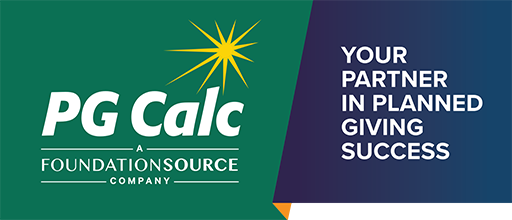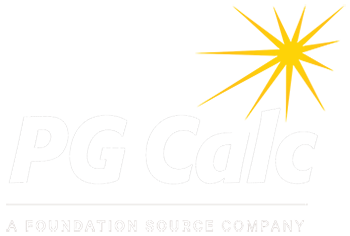Featured Articles
PG Calc publishes monthly articles on the latest topics in planned giving.
“Please, Sir, I Want Some More” - The Plight of Orphan DAFs
-What happens when there is money left in a donor advised fund after the last donor-advisor has died? Where does that money go? Who decides how the money is used? Like a street urchin in a Charles Dickens novel, an “orphan donor advised fund” can sometimes achieve great expectations or, sadly, pass invisibly without much impact. And, like Dickens’ obsession with orphans, there are those who are concerned about the growing orphan population and some who would exploit these orphans for their own purposes.
Partial Interest Gifts – Navigating Rocky Shoals and Avoiding Whirlpools
-Contributions of appreciated assets offer tax savvy opportunities for gift planning. But what if the donor is not eager to part with the entire asset? That’s no problem if the asset is securities; our donor simply transfers as many shares as she chooses and keeps the rest for herself. However, other assets aren’t so easily divided – things like real estate or bank, investment, or retirement accounts. A contribution of a partial interest can allow donors to give a portion of the property and retain the rest for themselves, their family, or others.
Navigating a contribution of a partial interest can be a bit like the challenges Odysseus faced on his journey home. It wasn’t all smooth sailing. He had to navigate rocky shoals, whirlpools, and angry gods, but eventually, he made it home safely.
Is Your Charity “Effective?” - Effective Altruism and Your Donors
-Recently, researchers at the Harvard Center for Brain Science crafted an experiment to see if donors could be redirected from supporting their favorite charities (“giving from the heart”) to supporting more effective charities (“giving from the head”). The effective charities were selected from GiveWell, a charity navigator for the Effective Altruism (EA) movement, which also funded the study through the Effective Altruism Fund. If your only familiarity with EA is its relationship to disgraced cypto-currency billionaire Sam Bankman-Fried, it’s worth learning a bit about the movement and how it’s working to change the nature of philanthropy.
EA encourages its followers to earn more, so they can give more and to support only the most effective charities with their giving. According to EA, an effective charitable gift benefits the most people for the least financial outlay.
Do you need to worry that EA will capture your donors? They’re certainly going to try.
That’s Alright – It Was Only Money (Putting 2022 in the Rearview Mirror)
-We’ve been saying for years that, when it comes to investments, charities should focus on the long-term picture. There are good years in the markets and bad years in the markets, but, with “prudent” investments, the long-term outcomes have been consistently positive. Whether it be the endowment assets of well-established organizations, or the investment portfolios of gift annuity programs and individual charitable remainder trusts, the general rule is to look at the bigger picture. But specific and dramatic swings in the investment markets – the stock market in particular – can have a chilling effect on donors with stock portfolios held over an extended period of time.
What do we say to the donors who have seen their investments lose significant value over the past 12 months or longer? And even within the organization, how do we respond to the more cautious voices among us who are spooked by double-digit declines in market values? We thought it would be helpful to take a look at the most recent investment performance measurements of mainstream investments.
Thou Shalt Not Alter Thy Gift Annuity Agreements
-This question comes up from time to time: can the non-profit organization that is sponsoring charitable gift annuities modify its templates for the gift annuity agreements? Sometimes a person at the sponsoring charity wants to change portions of the agreements from an aesthetic standpoint – they want the language to be more flowing, or they have unique terminology they would like to be incorporated into the agreements. In other situations, there is concern about the technical aspects of the agreements – perhaps a consultant or some other outside advisor thinks the terms should be stated differently. Whatever interest there is – however well-intended – behind the idea of modifying the gift annuity agreement templates, our general recommendation is NO! – don’t do it – don’t even think about doing it! Let’s discuss some of the reasons why.
Rapid Ascent of IRS Discount Rate Creates Opportunities
-In February, the IRS discount rate was 1.6%. In December, it is up to 5.2%, more than triple what it was just ten months ago. This dramatic change coincides with a similar escalation of interest rates in the U.S. generally, as well as increased nervousness over whether the rapid rise in interest rates might soon tip the economy into a recession.
Don’t freak out over the swift shift in economic conditions. View it as an opportunity. This is a great time to renew contact with your donors and educate them about gift plans they might want to consider in this new economic reality.
The December 15th (Sort Of) Outright Real Estate Gift
-At some point in your fundraising career, you will be asked to pull a rabbit out of a hat. You will deal with a donor who wakes up on December 15th with a burning desire to establish a $1M lead trust, or to establish a charitable remainder trust with mutual funds, or make an outright gift of real estate. And in the eager donor’s mind, these should all be easily doable for your charity by year end ‒ after all, you’ve got two whole weeks to pull it off!
While we can’t guarantee a successful mutual fund transfer into a CRT after December 15th (we’re magicians, not miracle workers), we do have a suggestion for handling the last-minute, year-end, Hail Mary pass of an outright gift of real estate.
Is a Planned Giving Program Worth It? Some Food for Thought
-Many planned giving officers have been confronted with the question, “Is planned giving worth it?” If you’re lucky, you asked yourself that question while digging your car out of the snow for a Monday morning commute in February. If you’re unlucky, you’ve been asked that question point blank in a meeting with your Chief Advancement Officer (CAO) or Chief Financial Officer (CFO).
To help you answer that question, invest a couple of hours in examining your planned giving program through that lens and ask yourself, “Is it worth it?”
New IRS Rules on Inherited IRAs Could Increase Attractiveness of Charitable Giving
-Solicitations for testamentary gifts from IRAs are often an easy ask. The donor can name a charity (or charities) to benefit from all or just a fraction of their IRA account without revising their will (and paying their attorney’s fees). Because of the ease of the ask and the prevalence of IRA holdings by donors, fundraisers should be aware when changes to IRA regulations might sway a donor towards an IRA gift.
Earlier this year, the IRS released proposed regulations that take a new position affecting required minimum distributions (RMDs) for inherited IRAs and the considerable financial penalty (up to 50%!) for failure to take an RMD. But don’t be misled by the word “proposed,” unlike proposed Federal regulations, proposed IRS regulations immediately go into effect. The upside of the IRS’s position is that it also enhances the attractiveness of testamentary charitable gift annuities (CGAs) and charitable remainder trusts (CRTs) funded by IRAs.
The Geomorphology of Planned Giving
-I once worked with a geologist who suggested that planned giving could take some valuable lessons from the field of geomorphology. Both geology and planned giving involve dynamic relationships that change slowly over time and processes that are not readily amenable to experimentation or precise measurement. Both fields are cursed with uncertainty and complexity with long periods of small incremental change punctuated by large-scale events. And geologists and planned giving officers must wrestle with expectations that they should be able to precisely predict events that are stubbornly unpredictable.
Over the years, much has been written about “metrics” for planned giving programs. At first blush, it seems simple: just count the money as it comes in. However, tying results to current activity is more complicated when it comes to planned gifts.

